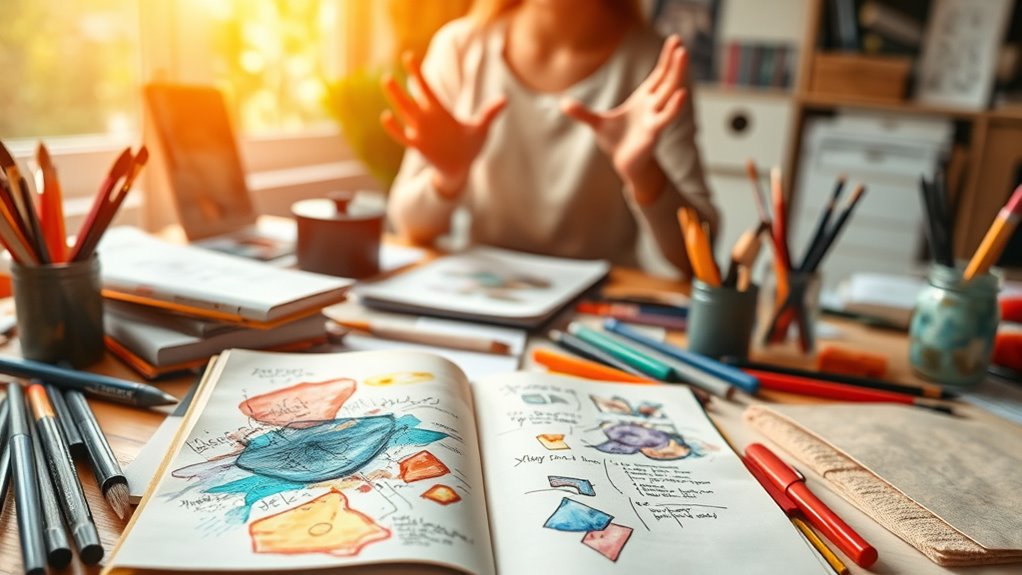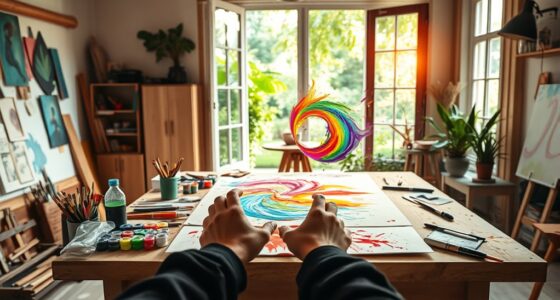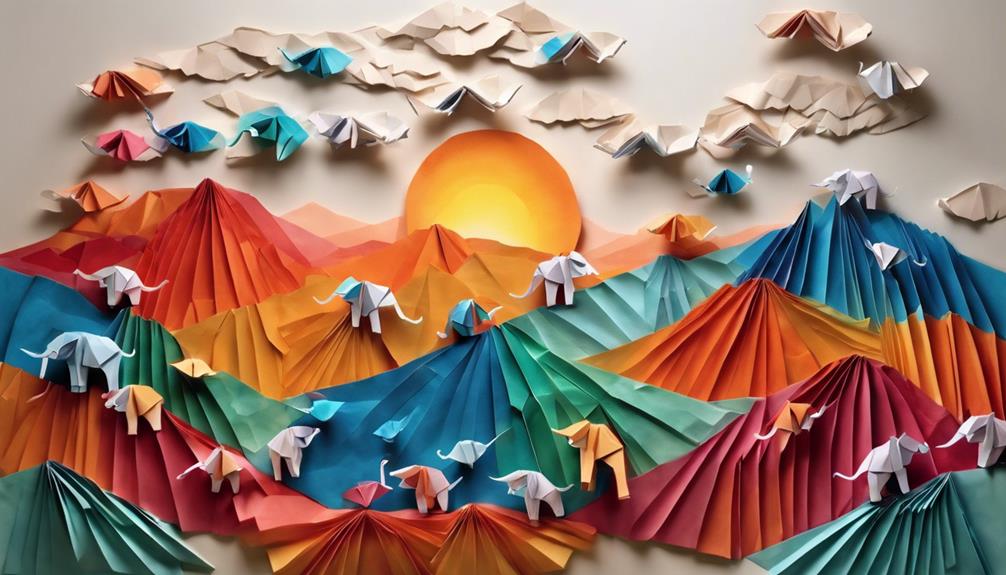Using constraint-based exercises can unlock your creativity by challenging your typical thinking patterns and pushing you to innovate within set limits. Restrictions like time, resources, or thematic boundaries guide focus, inspire fresh perspectives, and encourage resourcefulness. Implementing strategies such as random word associations or role playing helps you explore new ideas. To discover even more ways to harness constraints for your creative growth, keep exploring the concepts that follow.
Key Takeaways
- Constraints activate specific cognitive pathways, prompting inventive problem-solving and fostering innovative ideas.
- Limiting resources or setting thematic boundaries guides focus, inspiring resourcefulness and unique solutions.
- Reversing or layering constraints encourages flexible thinking and unblocks fresh perspectives outside traditional approaches.
- Practical exercises like random word associations and role-playing stimulate creativity within defined limits.
- Balancing challenge and freedom in constraints promotes continuous growth and helps generate novel, outside-the-box ideas.
The Science Behind Constraints and Creativity
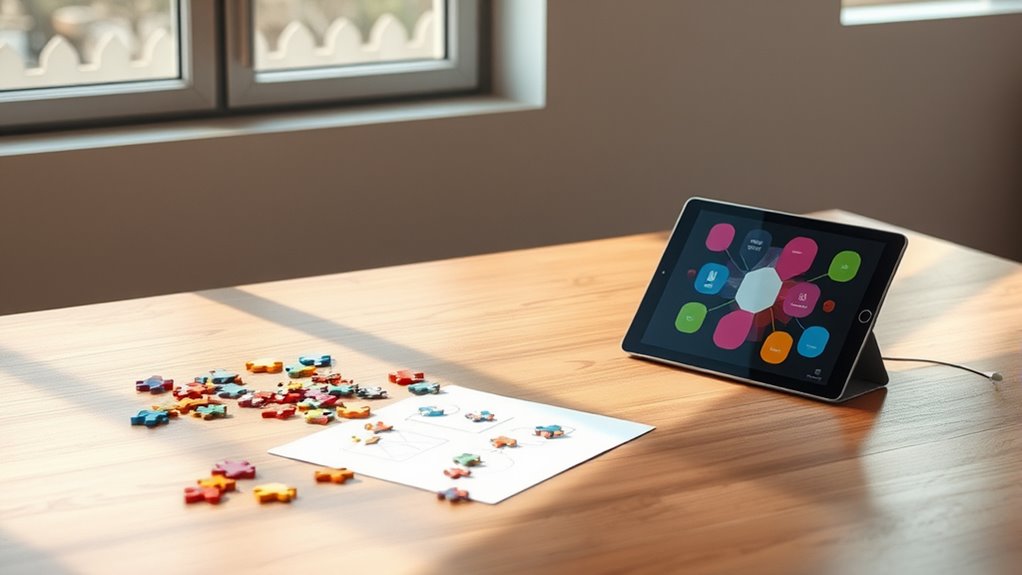
Constraints often get a bad rap, but they actually play a crucial role in sparking creativity. When you face limits, your psychological impact shifts; it forces your mind to focus and adapt, rather than wander aimlessly. These constraints influence your cognitive processes by narrowing options, encouraging problem-solving, and fostering innovative thinking. Instead of overwhelming you, restrictions create a mental framework that pushes you to think differently. The science shows that constraints don’t hinder your creativity—they activate specific cognitive pathways that promote inventive ideas. For example, high refresh rates in projectors can challenge designers to optimize visuals within technical limits, demonstrating how constraints can inspire inventive solutions. By understanding this, you can harness limitations to enhance your creative potential rather than see them as obstacles.
How Imposed Limits Stimulate Innovation
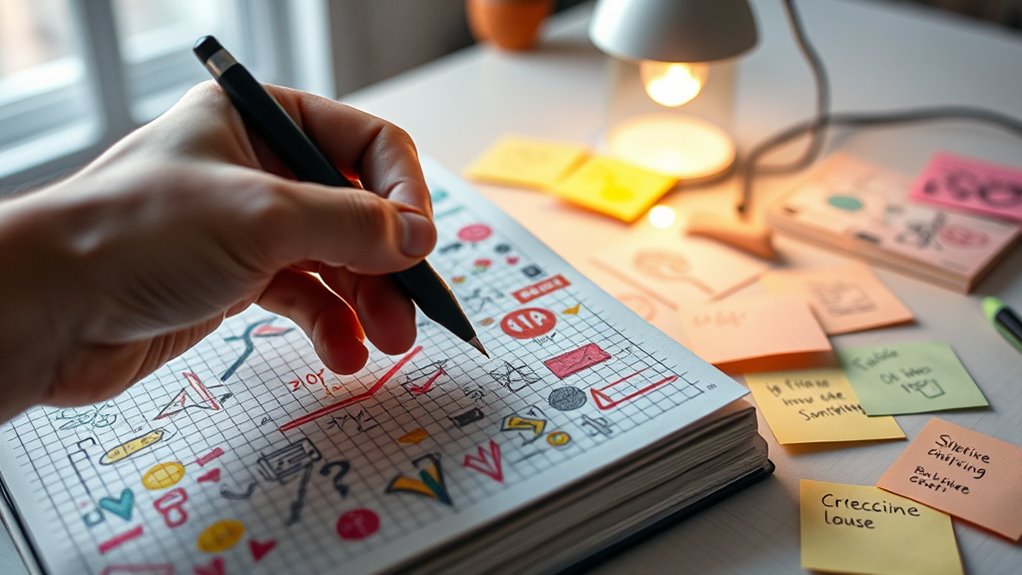
Imposed limits can be powerful catalysts for innovation because they force you to think differently and challenge your usual approaches. When faced with design limitations or artistic boundaries, you’re pushed to find unique solutions within constraints, sparking creativity. These boundaries eliminate options, guiding focus and encouraging resourcefulness. Sometimes, restrictions reveal hidden opportunities you wouldn’t see otherwise. For example, using an eye patch can temporarily alter your perspective, inspiring new ways to approach problems or creative projects.
Setting Effective Constraints for Creative Growth
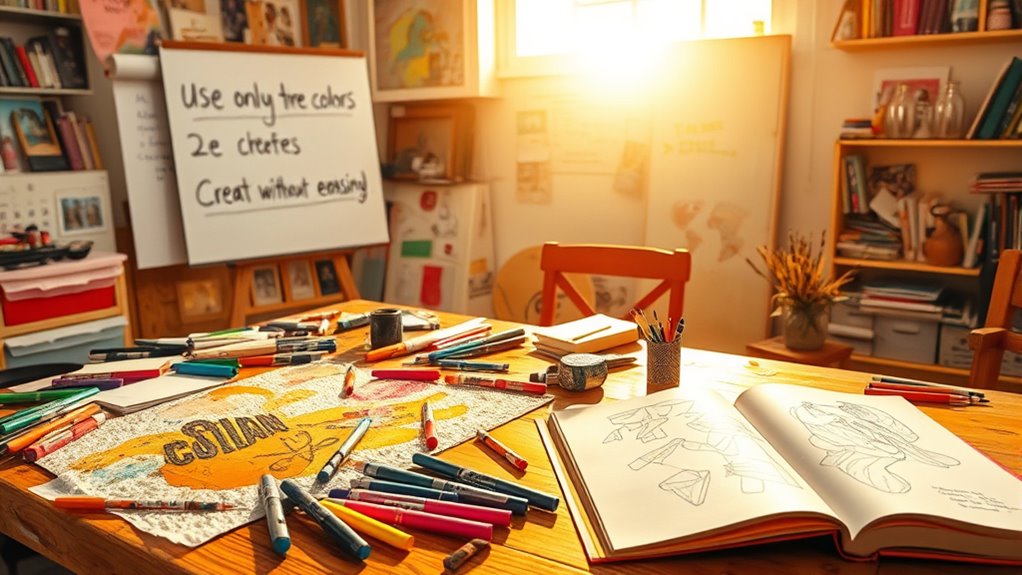
To foster meaningful creative growth, you need to set constraints that challenge you without stifling your innovation. Effective constraints encourage collaborative brainstorming and promote idea incubation, helping you explore new perspectives. When establishing these limits, focus on clarity and purpose, ensuring they push your boundaries while leaving room for experimentation. Balance is key—too strict, and creativity stalls; too loose, and focus weakens. Consider constraints like time limits, resource restrictions, or thematic boundaries. These guide your thinking without suffocating it. By carefully designing constraints, you create an environment where ideas can incubate and flourish, fostering continuous growth and fresh insights.
Set thoughtful constraints to spark innovation, foster growth, and encourage fresh insights without limiting your creative potential.
- Define specific, achievable goals
- Limit available resources creatively
- Set time-bound challenges
- Impose thematic or stylistic boundaries
- Encourage collaborative brainstorming sessions
Examples of Successful Constraint-Based Projects
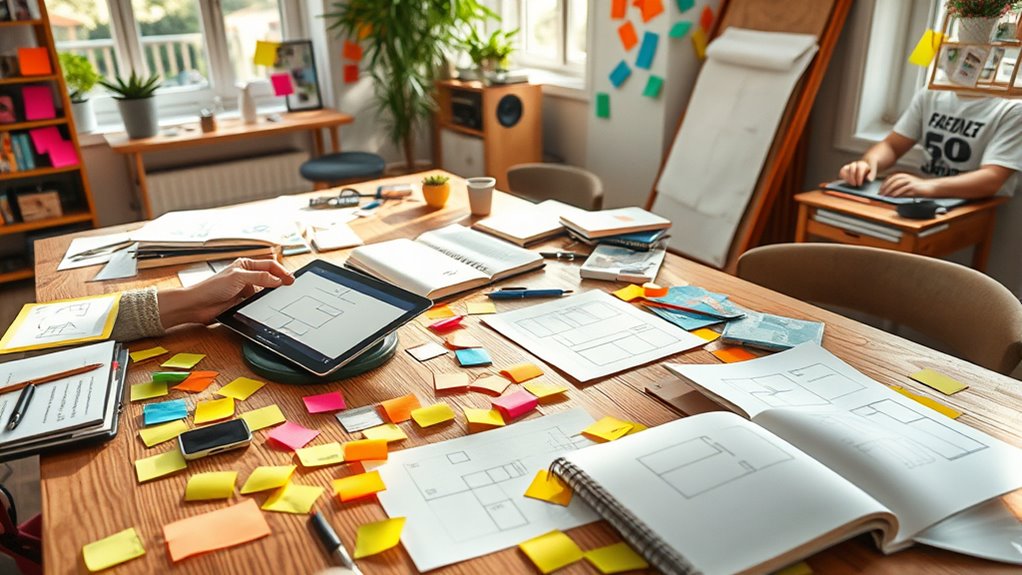
| Project | Constraint Benefit |
|---|---|
| Google Chrome Logo | Simplifies design, enhances recognition |
| *Minecraft* | Fosters innovative gameplay |
| TED Talks | Time limits boost clarity |
| Character limits inspire concise messaging |
Practical Exercises to Cultivate Creative Thinking
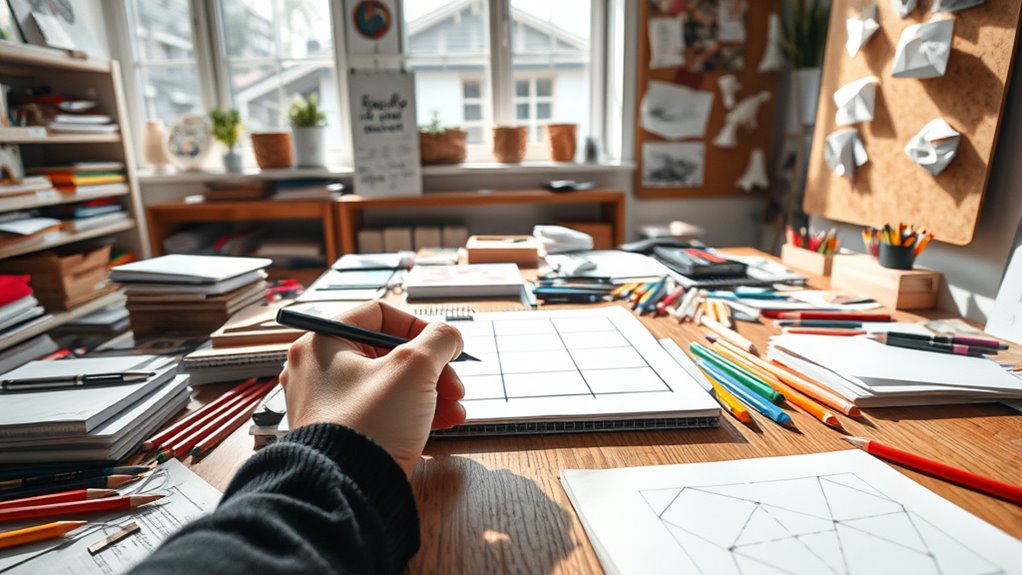
Practicing specific exercises can substantially boost your creative thinking skills. These activities encourage mindset shifts and leverage collaborative techniques, making idea generation more dynamic. Try these practical exercises:
- Random Word Associations: Pick a word and connect it to your problem to spark new ideas.
- Constraint Reversal: Challenge yourself to solve problems by intentionally reversing constraints.
- Role Playing: Adopt different perspectives to gain fresh insights.
- Group Brainstorming: Use collaborative techniques to build on others’ ideas and expand your thinking.
- Limit Setting: Impose boundaries on resources or time to force innovative solutions.
- Incorporating interior design principles can also inspire creative thinking by fostering environments that stimulate innovation.
These exercises help you develop flexibility, adapt to constraints, and foster a creative mindset that thrives on collaboration. Regular practice sharpens your ability to think outside the box.
Overcoming Resistance to Constraints
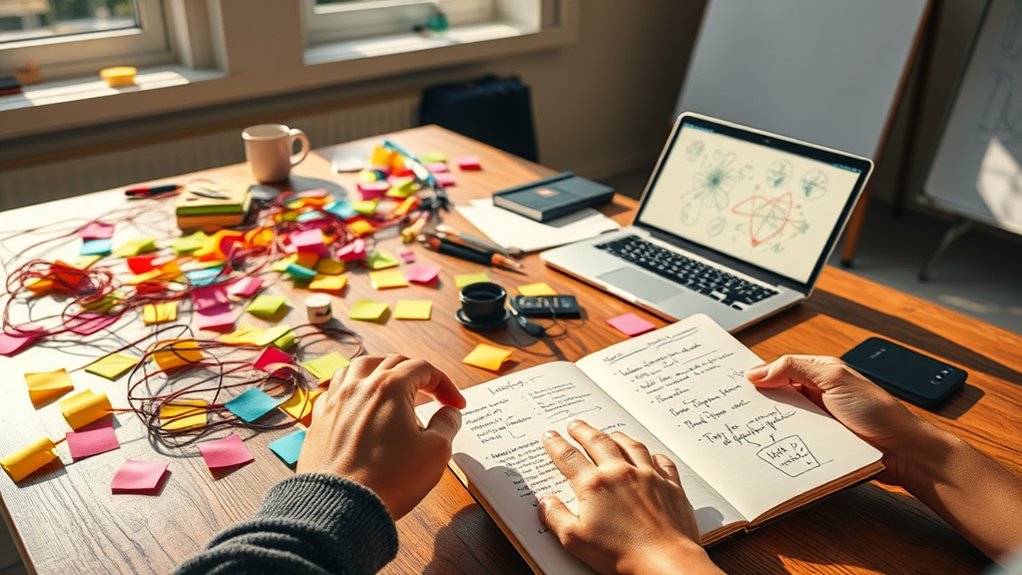
Constraints can feel limiting, but they also open doors to new ideas when you see them as opportunities. Challenging your mindset helps you view restrictions not as obstacles but as creative prompts. By shifting how you perceive limits, you can unseal fresh perspectives and innovative solutions. Embracing celebrity transformations demonstrates how adapting to constraints can lead to remarkable personal growth.
Subheading 1: Embracing Limitations as Opportunities
Although many see limitations as barriers, they can actually serve as powerful catalysts for creativity. Limitations inspire you to think differently and find innovative solutions within boundaries. When you view constraints as opportunities, you foster a mindset that encourages resourcefulness and adaptability. Embracing these boundaries helps you focus your ideas and avoid distractions, making your creative process more efficient. Instead of resisting constraints, recognize how they push you to explore new angles and refine your work. By shifting your perspective, you can turn limitations into advantages. Remember, boundaries foster discipline and clarity, strengthening your creative muscles. Recognizing the importance of restrictions can further enhance your ability to innovate within set parameters.
Subheading 2: Challenging Mindsets Toward Constraints
While viewing limitations as opportunities can boost your creativity, many people instinctively resist constraints, seeing them as obstacles to overcome. This resistance often stems from belief barriers—deep-seated thoughts that constraints hinder progress. To *liberate* your creative potential, you need to challenge these mindset shifts. Recognize that constraints can foster innovation by forcing you to think differently and prioritize ideas. Start by questioning your assumptions about limitations, and reframe them as catalysts for problem-solving. Embracing this shift requires conscious effort, but over time, it becomes easier to see constraints as tools rather than barriers. By redefining your relationship with limitations, you open yourself up to new possibilities and creative breakthroughs you might have previously dismissed. Additionally, understanding that limits can inspire resourcefulness encourages a more positive perspective on constraints.
Adapting Constraints to Different Creative Fields
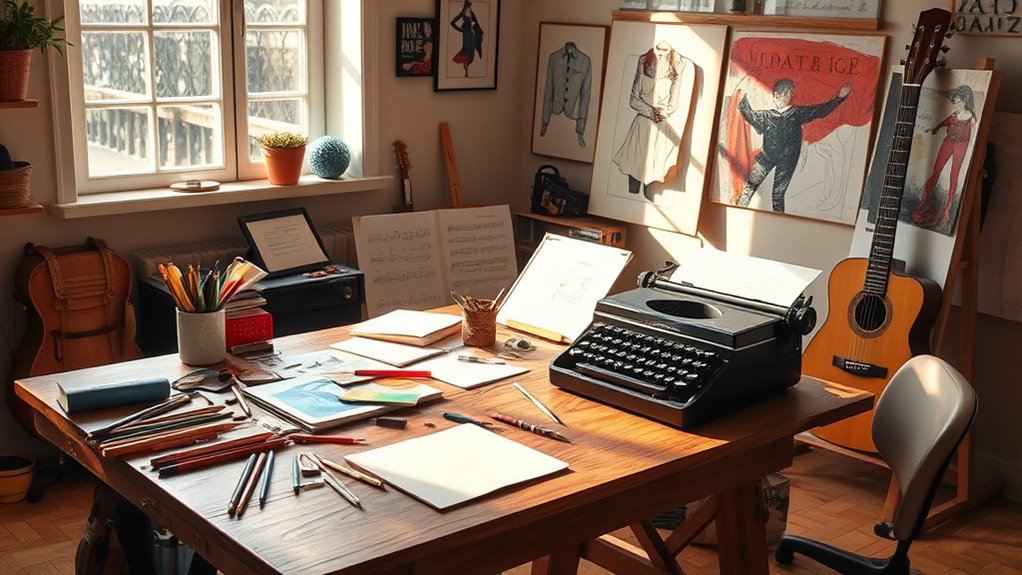
Constraints shape your creative process differently depending on your field. In visual arts, they might limit your color palette or canvas size, sparking innovation. In writing, they could be a word count or a specific theme, guiding your storytelling approach. Incorporating multi-functional gear or adaptable tools can also inspire resourcefulness within constraints, encouraging innovative solutions.
Constraints in Visual Arts
Have you ever wondered how constraints shape the creative process in visual arts? They push you to explore new techniques and perspectives. For example, using color theory as a constraint guides your palette choices, inspiring innovative combinations. Cultural influences serve as thematic limits, shaping your subject matter and style. Constraints can challenge your technical skills, like working within specific formats or mediums. They also encourage symbolic or conceptual experimentation, adding depth to your work. By embracing these limitations, you discover fresh ideas and unique visual languages. Additionally, understanding mental resilience can help artists adapt to and thrive within creative constraints, leading to more innovative outcomes.
Constraints in Writing
Ever wondered how constraints can ignite creativity in writing? Constraints push you to explore new ideas like genre blending, where mixing different styles sparks fresh perspectives. They encourage narrative experimentation, helping you break free from predictable storytelling. By setting deliberate limits—such as writing a story without adjectives or within a specific word count—you challenge your creativity and discover unexpected solutions. Constraints serve as a framework that fuels innovation, prompting you to think outside the box. Whether you’re blending genres or experimenting with narrative structure, these boundaries become tools to deepen your craft. Additionally, understanding store hours can help plan visits to creative workshops or events at local beauty stores, further enriching your inspiration. Instead of feeling restricted, you’ll find constraints inspiring, guiding you toward more inventive and compelling writing.
Combining Multiple Constraints for Greater Innovation
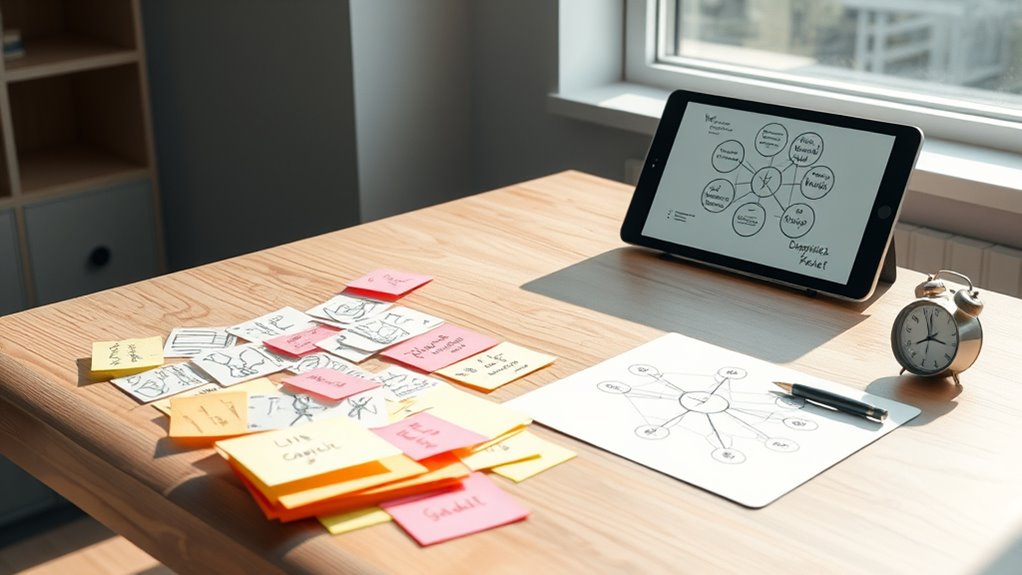
How can combining multiple constraints spark greater innovation? By layering different limitations, you force yourself to think creatively within tighter bounds, often leading to unexpected ideas. Combining constraints encourages collaborative brainstorming, where diverse perspectives help navigate complex challenges. Flexibility with constraints is key—you can adjust and adapt, fostering a dynamic environment for innovation. This approach pushes you to explore new solutions beyond straightforward thinking, unblocking fresh perspectives. Incorporating AI applications in learning and entertainment can further enhance the creative process by providing new tools and insights.
Tracking Progress and Measuring Creativity Gains
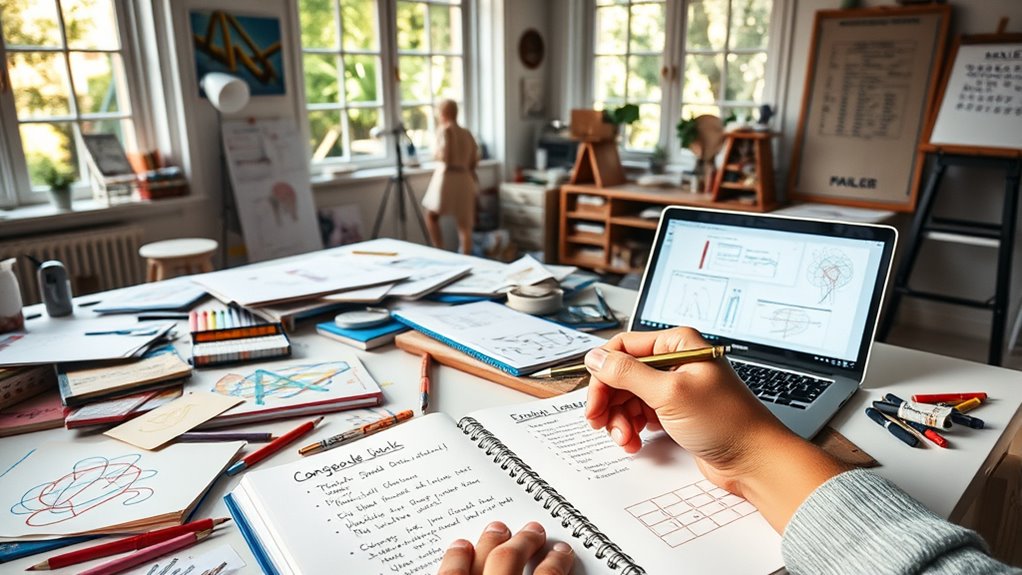
To effectively track your creative progress, you need clear metrics that reflect your growth. Using visual tools like charts or journals makes it easier to see improvements over time. Regular reflection helps you understand your creative strengths and identify areas for further development.
Establish Clear Metrics
Have you ever wondered how to accurately gauge your creative progress? Establishing clear metrics helps you track growth and refine your approach. In constraint psychology, understanding specific indicators boosts your ability to measure success. Focus on tangible outcomes like completed projects or new ideas generated. Consider qualitative feedback from creative collaboration sessions to assess innovation. Set benchmarks for challenge levels to observe how you adapt. Track time spent in creative activities to identify patterns. Use these metrics to stay motivated and adjust exercises as needed. Clear measurements provide insight into your development, making your creative journey more intentional. Remember, effective metrics are specific, measurable, and aligned with your goals, helping you navigate constraints and *access* your full creative potential.
- Completed projects or ideas
- Feedback from collaborators
- Challenge levels and adaptability
- Time spent in creative exercises
- Personal growth benchmarks
Use Visual Progress Tools
Visual progress tools serve as powerful allies in your creative journey by transforming abstract growth into tangible, trackable forms. They encourage mindset shifts, helping you see your development clearly and stay motivated despite resource limitations. By visually charting your progress—such as sketches, mood boards, or timelines—you gain immediate feedback on your efforts. These tools make improvements and setbacks visible, fostering a sense of achievement and identifying areas for growth. Using visual progress tools also helps you stay focused and committed, as you can celebrate small wins along the way. Ultimately, they turn your creative evolution into an ongoing, measurable process, making it easier to recognize progress and adjust your strategies accordingly.
Reflect on Creative Growth
How can you truly measure your creative growth? It’s about recognizing mindset shifts and how your approach evolves over time. Reflecting on progress helps you identify breakthroughs and areas for improvement. Tracking creativity gains isn’t just about finished projects; it’s about understanding your problem-solving process, embracing new techniques, and fostering collaborative techniques that expand your perspective. To gauge growth, consider these ideas:
- Comparing early and recent work to spot improvements
- Noting changes in your problem-solving approach
- Recognizing increased confidence in ideas
- Tracking the adoption of new techniques
- Reflecting on feedback from peers and collaborators
These methods help you see tangible progress and reinforce a growth mindset, fueling ongoing creative development.
Tips for Maintaining Motivation During Constraints
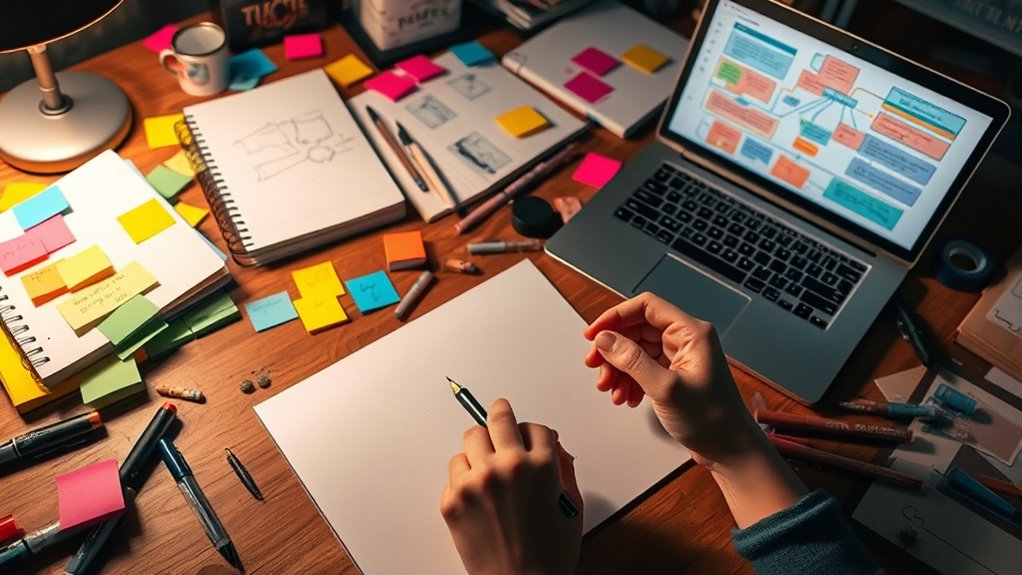
When facing constraints, maintaining motivation can feel challenging, but it’s essential to stay focused on your creative goals. Mindset shifts help you see limitations as opportunities rather than obstacles. Break your goals into smaller, manageable tasks to keep momentum. Celebrate small wins to boost confidence and motivation. Use the table below to remind yourself of key strategies:
| Strategy | Benefit |
|---|---|
| Reframe constraints | Sparks creativity by viewing limits as ideas |
| Set achievable goals | Prevents overwhelm, maintains progress |
| Track progress | Provides visual motivation and clarity |
| Seek support | Encourages accountability and fresh perspectives |
Stay adaptable, focus on progress, and keep your eyes on the bigger picture.
Frequently Asked Questions
How Do Constraints Differ Across Various Creative Disciplines?
You’ll notice that constraints vary across creative disciplines. In music, genre boundaries shape your style, while technical limitations like instrument range guide your composition. Visual arts might restrict your palette or canvas size, and in writing, word count or genre conventions define your approach. These constraints push you to innovate within set parameters, transforming limitations into opportunities for unique expression across every discipline.
Can Constraints Stifle Long-Term Creative Vision?
You might worry that constraints could stifle your long-term creative vision, but they often push you to innovate within clear boundaries, expanding your innovation boundaries. Instead of limiting your creative freedom, constraints challenge you to think differently and find unique solutions. By setting intentional limits, you can maintain focus and develop a more cohesive vision over time. Constraints, when used wisely, enhance your creativity rather than hinder it.
What Are Common Pitfalls When Implementing Constraints?
When you implement constraints, you might face common pitfalls like overlooking perceived limitations, which can hinder your progress. These perceived limitations often create innovation barriers, making you hesitant to explore new ideas. You may also impose overly strict rules that restrict creativity instead of fostering it. To avoid these issues, stay flexible, view constraints as opportunities, and encourage experimentation, ensuring that limitations fuel innovation rather than stifle it.
How Do Cultural Differences Influence Constraint-Based Creativity?
They say, “Different strokes for different folks,” and that’s true for constraint-based creativity. Cultural differences shape your understanding of artistic boundaries and influence how you approach constraints. Cultural narratives guide what you see as possible or taboo, impacting your inventive process. Embracing these diverse perspectives helps you see constraints not as limits but as opportunities to explore new ideas within your cultural context, fueling truly unique creativity.
Are There Psychological Effects of Working Within Strict Limits?
When you work within strict limits, you might find it challenges your mental flexibility, forcing you to think creatively within boundaries. It can also boost your emotional resilience, helping you manage frustration and adapt to constraints. These psychological effects enhance your problem-solving skills and foster a stronger mindset, making you more resourceful. Embracing constraints can ultimately strengthen your ability to navigate difficulties with a positive attitude and innovative thinking.
Conclusion
By embracing constraints, you open a world where boundaries become your canvas, shaping your ideas like a sculptor chiseling marble into art. Instead of feeling limited, see constraints as guiding stars that illuminate new paths of creativity. With each imposed limit, you carve out fresh perspectives and possibilities. So, step into this space of disciplined freedom, and watch your imagination flourish like a garden blossoming within a carefully fenced enclosure.
